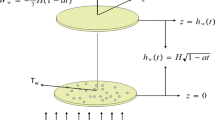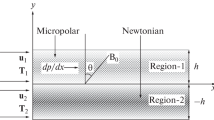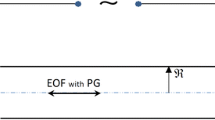Abstract
This paper is devoted to studying the thermal characteristics of a completely developed electrokinetic flow of micropolar fluid through a cylindrical microtube when a static electric field is applied to it. Due to the constant heat flux applied, the microtube wall is supposed to get heated continuously. In addition to this, the local thermal equilibrium (LTE) model is taken into account while analyzing the heat transfer phenomenon. Under low Reynolds numbers and long channel length approximations, the partial differential equations that describe the electrothermal flow of non-Newtonian micropolar fluid have been switched to ordinary differential equations. The finite difference method (FDM) is used to calculate velocity and temperature with second-order precision using uniform grids along the microtube’s radial direction. The Cavalieri–Simpson technique for numerical integration was used to get numerical values for the mean velocity, bulk mean temperature, and mean entropy/Bejan number. Variations in the Nusselt number for changes in velocity and temperature fields and fluctuations in the Bejan number due to heat transfer irreversibility have been presented. Moreover, a comprehensive study has been performed to discuss the impact of pertinent factors on the optimization of the system’s irreversibility through mean entropy generation analysis. Thermofluidic micropumps for chemical mixing/separation and biomicrofluidic devices for diagnostics may be designed using the results obtained from this study.

















Similar content being viewed by others
Abbreviations
- \(\textbf{U}\) :
-
Velocity vector
- \(\textbf{F}\) :
-
External body force vector
- \(\textbf{W}\) :
-
Micro-rotational vector
- \(\textbf{I}\) :
-
Gyration coefficient vector
- \(\textbf{E}\) :
-
Electric field vector
- T :
-
Temperature
- R :
-
Radius of microtube
- \({E}_0\) :
-
Characteristic electric field
- p :
-
Pressure
- t :
-
Time
- k :
-
Thermal conductivity
- e :
-
Protonic charge
- n :
-
Micropolarity concentration parameter
- \({n}_0\) :
-
Bulk ionic concentration
- \({n}^\pm\) :
-
Ionic densities
- a :
-
Micropolarity parameter
- b :
-
Couple stress parameter
- \({k}_{\mathrm{b}}\) :
-
Boltzmann constant
- \({c}_\mathrm{p}\) :
-
Specific heat capacity
- \({u}_{\mathrm{s}}\) :
-
Helmholtz–Smoluchowski velocity
- \({q}_{\mathrm{w}}\) :
-
Heat flux
- \({u}_{\mathrm{a}}^*\) :
-
Average/mean velocity
- \({T}_{\mathrm{a}}\) :
-
Average/mean Temperature
- \({T}_{\mathrm{m}}\) :
-
Bulk mean temperature
- \({I}_{\mathrm{s}}^*\) :
-
Streaming current
- \({I}_{\mathrm{c}}^*\) :
-
Conduction current
- \({I}_{\mathrm{T}}^*\) :
-
Stern layer current
- \(\text{Du}\) :
-
Dukhin number
- \({T}_{\mathrm{s}}\) :
-
Microtube’s surface temperature
- \(\text{Pe}\) :
-
Peclet number
- \(\text{Br}\) :
-
Brinkman number
- S :
-
Joule heat parameter
- \(\text{Nu}\) :
-
Nusselt number
- \(\text{Be}\) :
-
Bejan number
- \(\rho\) :
-
Fluid density
- \(\mu\) :
-
Fluid viscosity
- \(\eta\) :
-
Material constant of fluid
- \(\gamma\) :
-
Angular viscosity coefficient
- \(\Phi\) :
-
Viscous dissipation factor
- \(\Psi\) :
-
Electrical potential
- \(\rho _\mathrm{e}\) :
-
Net ionic charge density
- \(\wp\) :
-
Steric factor
- \(\varsigma\) :
-
Ionic valency
- \(\epsilon\) :
-
Medium permittivity
- \(\lambda\) :
-
Electrokinetic parameter
- \(\rho _\mathrm{e}\) :
-
Net charge density
- \(\Gamma\) :
-
Velocity scale ratio
- \(\psi ^*\) :
-
Impulsively produced electric potential
- \(\zeta ^*\) :
-
Zeta potential
- \(\beta ^*\) :
-
Slip length
- \(\sigma _{\mathrm{S}}\) :
-
Stern layer electrical conductivity
- \(\sigma _{\mathrm{B}}\) :
-
Bulk electrical conductivity
- \(\sigma _\mathrm{e}\) :
-
Electrical conductivity of the fluid
- \(\xi\) :
-
Conductivity parameter
- \(\theta _{\mathrm{m}}\) :
-
Dimensionless bulk mean temperature
- \(\Omega\) :
-
Temperature difference parameter
References
Harrison DJ, Fluri K, Seiler K, Fan Z, Effenhauser CS, Manz A. Micromachining a miniaturized capillary electrophoresis-based chemical analysis system on a chip. Science. 1993;261:895–7.
Manz A, Effenhauser CS, Burggraf N, Harrison DJ, Seiler K, Fluri K. Electroosmotic pumping and electrophoretic separations for miniaturized chemical analysis systems. J Micromech Microeng. 1994;4(4):257–65.
Gravesen P, Branebjerg J, Jensen OS. Microfluidics-a review. J Micromech Microeng. 1993;3(4):168–82.
Mala GM, Li D, Dale J. Heat transfer and fluid flow in microchannels. Int J Heat Mass Transf. 1997;40(13):3079–88.
Soong C, Wang S. Theoretical analysis of electrokinetic flow and heat transfer in a microchannel under asymmetric boundary conditions. J Colloid Interface Sci. 2003;265(1):202–13.
Li D. Electrokinetics in microfluidics. Amsterdam: Elsevier; 2004.
Chakraborty S. Analytical solutions of Nusselt number for thermally fully developed flow in microtubes under a combined action of electroosmotic forces and imposed pressure gradients. Int J Heat Mass Transf. 2006;49(3–4):810–3.
Jing D, Bhushan B. The coupling of surface charge and boundary slip at the solid-liquid interface and their combined effect on fluid drag: a review. J Colloid Interface Sci. 2015;454:152–79.
Steinberger A, Cottin-Bizonne C, Kleimann P, Charlaix E. High friction on a bubble mattress. Nat Mater. 2007;6(9):665–8.
Karatay E, Haase AS, Visser CW, Sun C, Lohse D, Tsai PA, Lammertink RG. Control of slippage with tunable bubble mattresses. Proc Natl Acad Sci. 2013;110(21):8422–6.
Tan D, Liu Y. Combined effects of streaming potential and wall slip on flow and heat transfer in microchannels. Int Commun Heat Mass Transf. 2014;53:39–42.
Ranjit N, Shit G, Tripathi D. Electrothermal analysis in two-layered couple stress fluid flow in an asymmetric microchannel via peristaltic pumping. J Therm Anal Calorim. 2021;144(4):1325–42.
Tripathi D, Prakash J, Reddy MG, Misra JC. Numerical simulation of double diffusive convection and electroosmosis during peristaltic transport of a micropolar nanofluid on an asymmetric microchannel. J Therm Anal Calorim. 2021;143:2499–514.
Munawar S, Saleem N, Tripathi D. Cilia and electroosmosis induced double diffusive transport of hybrid nanofluids through microchannel and entropy analysis. Nonlinear Eng. 2023;12(1):20220287.
Narla V, Tripathi D, Bhandari D. Thermal analysis of micropolar fluid flow driven by electroosmosis and peristalsis in microchannels. Int J Ambient Energy. 2022;43(1):8193–205.
Narla V, Tripathi D, Bhandari D, Bég OA. Electrokinetic insect-bioinspired membrane pumping in a high aspect ratio bio-microfluidic system. Microfluid Nanofluid. 2022;26(11):85.
Prakash J, Balaji R, Tripathi D, Tiwari AK, Sharma R. Composite nanofluids flow driven by electroosmosis through squeezing parallel plates in presence of magnetic fields, In: Advancements in nanotechnology for energy and environment. Springer; 2022. p. 273–93.
Akram J, Akbar NS, Alansari M, Tripathi D. Electroosmotically modulated peristaltic propulsion of TiO2/10W40 nanofluid in curved microchannel. Int Commun Heat Mass Transf. 2022;136: 106208.
Akram J, Akbar NS, Tripathi D. Analysis of electroosmotic flow of silver-water nanofluid regulated by peristalsis using two different approaches for nanofluid. J Comput Sci. 2022;62: 101696.
Lu D, Noreen S, Waheed S, Tripathi D. Heat transfer applications in curved micro-channel driven by electroosmosis and peristaltic pumping. J Mech Med Biol. 2022;22(05):2250030.
Balaji R, Prakash J, Tripathi D, Bég OA. Computation of magnetohydrodynamic electro-osmotic modulated rotating squeezing flow with zeta potential effects. Colloids Surf A. 2022;640: 128430.
Akram J, Akbar NS, Tripathi D. Electroosmosis augmented MHD peristaltic transport of SWCNTs suspension in aqueous media. J Therm Anal Calorim. 2022;147: 2509–2526.
Misra JC, Maiti S. Peristaltic pumping of blood through small vessels of varying cross-section. J Appl Mech. 2012;79(6): 061003.
Kumar R, Tiwari AK, Tripathi D, Mishra A. Electromagnetic field induced alterations in fluid flow through lacuno-canalicular system of bone. Int J Mech Sci. 2022;217: 107036.
Oni MO, Jha BK, Ajibade AO. Interplay of dual streaming potentials on electroosmotic mixed convection flow in a vertical microannulus with joule heating effect. Int Commun Heat Mass Transf. 2022;131: 105839.
Gao X, Zhao G, Li N, Zhang J, Jian Y. The electrokinetic energy conversion analysis of viscoelastic fluid under the periodic pressure in microtubes. Colloids Surf A. 2022;646: 128976.
Xie Z. Electrokinetic energy conversion of core-annular flow in a slippery nanotube. Colloids Surf A. 2022;642: 128723.
Roy A, Dhar P. Micro-imbibition electro-magneto-hydrodynamics of viscoelastic fluids with interactive streaming potential. J NonNewton Fluid Mech. 2022;310: 104936.
Eringen AC. Simple microfluids. Int J Eng Sci. 1964;2: 205–17.
Eringen AC. Theory of micropolar fluids. J Math Mech. 1966;16(1): 1–18.
Hayakawa H. Slow viscous flows in micropolar fluids. Phys Rev E. 2000;61:5477.
Turk MA, Sylvester ND, Ariman T. On pulsatile blood flow. Trans Soc Rheol. 1973;17:1–21.
Misra JC, Ghosh SK. A mathematical model for the study of interstitial fluid movement vis-a-vis the non-Newtonian behaviour of blood in a constricted artery. Comput Math Appl. 2001;41:783–811.
Mehta A. Granular matter: an interdisciplinary approach. Berlin: Springer; 1994.
Papautsky I, Brazzle J, Ameel T, Frazier AB. Laminar fluid behavior in microchannels using micropolar fluid theory. Sens Actuators A. 1999;73:101–8.
Ariman T, Turk M, Sylvester N. Microcontinuum fluid mechanics-a review. Int J Eng Sci. 1973;11:905–30.
Ariman T, Turk M, Sylvester N. Applications of microcontinuum fluid mechanics. Int J Eng Sci. 1974;12:273–93.
Stokes VK. Theories of fluids with microstructure: an introduction. Berlin: Springer; 2012.
Lukaszewicz G. Micropolar fluids: theory and applications. Berlin: Springer; 1999.
Eringen AC. Microcontinuum field theories: II. Fluent media, vol. 2. Berlin: Springer; 2001.
Siddiqui AA, Lakhtakia A. Steady electro-osmotic flow of a micropolar fluid in a microchannel. Proc R Soc A Math Phys Eng Sci. 2009;465:501–22.
Siddiqui AA, Lakhtakia A. Non-steady electro-osmotic flow of a micropolar fluid in a microchannel. J Phys A Math Theor. 2009;42: 355501.
Misra JC, Chandra S, Shit GC, Kundu PK. Electroosmotic oscillatory flow of micropolar fluid in microchannels: application to dynamics of blood flow in microfluidic devices. Appl Math Mech. 2014;35:749–66.
Misra JC, Chandra S, Herwig H. Flow of a micropolar fluid in a micro-channel under the action of an alternating electric field: estimates of flow in bio-fluidic devices. J Hydrodyn. 2015;27:350–8.
Bejan A. Convection heat transfer. New York: Wiley; 2013.
Bejan A, Kestin J. Entropy generation through heat and fluid flow. J Appl Mech. 1983;50:451–63.
Bejan A. Entropy generation minimization: the method of thermodynamic optimization of finite-size systems and finite-time processes. Boca Raton: CRC Press; 2013.
Sarkar S, Ganguly S, Dutta P. Thermally developing combined magnetohydrodynamic and electrokinetic transport in narrow confinements with interfacial slip. Int J Heat Mass Transf. 2016;100:451–63.
Ranjit N, Shit G. Entropy generation on electro-osmotic flow pumping by a uniform peristaltic wave under magnetic environment. Energy. 2017;128:649–60.
Sarma R, Jain M, Mondal PK. Towards the minimization of thermodynamic irreversibility in an electrically actuated microflow of a viscoelastic fluid under electrical double layer phenomenon. Phys Fluids. 2017;29: 103102.
Matin MH, Khan WA. Entropy generation analysis of heat and mass transfer in mixed electrokinetically and pressure-driven flow through a slit microchannel. Energy. 2013;56:207–17.
Pabi S, Mehta SK, Pati S. Analysis of thermal transport and entropy generation characteristics for electroosmotic flow through a hydrophobic microchannel considering viscoelectric effect. Int Commun Heat Mass Transf. 2021;127: 105519.
Liu Y, Xing J, Jian Y. Heat transfer and entropy generation analysis of electroosmotic flows in curved rectangular nanochannels considering the influence of steric effects. Int Commun Heat Mass Transf. 2022;139: 106501.
Sujith T, Mehta SK, Pati S. Effect of finite size of ions on entropy generation characteristics for electroosmotic flow through microchannel considering interfacial slip. J Therm Anal Calorim. 2022. https://doi.org/10.1007/s10973-022-11731-8.
Das S, Ali A, Jana R, Makinde O. Edl impact on mixed magneto-convection in a vertical channel using ternary hybrid nanofluid. Chem Eng J Adv. 2022;12: 100412.
Reddy KV, Reddy MG, Makinde OD. Analysis of joule heating and chemical reaction effects in electroosmosis peristaltic transport of couple-stress and micropolar fluids. Heat Transf. 2022;51(6):4992–5014.
Monaledi RL, Makinde OD. Entropy generation analysis in a microchannel Poiseuille flows of nanofluid with nanoparticles injection and variable properties. J Therm Anal Calorim. 2021;143:1855–65.
Makinde OD, Eegunjobi AS. Entropy analysis of thermally radiating magnetohydrodynamic slip flow of Casson fluid in a microchannel filled with saturated porous media. J Porous Media. 2016;19(9):799–810.
Misra JC, Ghosh SK. Flow of a Casson fluid in a narrow tube with a side branch. Int J Eng Sci. 2000;38(18):2045–77.
Endalew MF, Sarkar S, Seth GS, Makinde OD. Dual-phase-lag heat transfer model in hydromagnetic second grade flow through a microchannel filled with porous material: A time-bound analysis. Rev Compos Mater Av. 2018;28(2):173.
Bikerman JJ. Structure and capacity of electrical double layer. Lond Edinb Dublin Philos Mag J Sci. 1942;33:384–97.
Kilic MS, Bazant MZ, Ajdari A. Steric effects in the dynamics of electrolytes at large applied voltages. I. Double-layer charging. Phys Rev E. 2007;75:021502.
Kilic MS, Bazant MZ, Ajdari A. Steric effects in the dynamics of electrolytes at large applied voltages. II. Modified Poisson–Nernst–Planck equations. Phys Rev E. 2007;75:021503.
Liu Y, Jian Y, Yang C. Steric-effect-induced enhancement of electrokinetic energy conversion efficiency in curved nanochannels with rectangular sections at high zeta potentials. Colloids Surf A. 2020;591: 124558.
Liu Y, Xing J, Jian Y. Heat transfer and entropy generation analysis of electroosmotic flows in curved rectangular nanochannels considering the influence of steric effects. Int Commun Heat Mass Transf. 2022;139: 106501.
Pandey D, Bhattacharyya S. Impact of surface hydrophobicity and ion steric effects on the electroosmotic flow and ion selectivity of a conical nanopore. Appl Math Model. 2021;94:721–36.
Mahapatra P, Ohshima H, Gopmandal PP. Electrophoresis of liquid-layer coated particles: impact of ion partitioning and ion steric effects. Langmuir. 2021;37:11316–29.
Nam-Trung N. Micro-magnetofluidics: interactions between magnetism and fluid flow on the microscale. Microfluid Nanofluid. 2012;12:1–16.
Das S, Chakraborty S, Mitra SK. Magnetohydrodynamics in narrow fluidic channels in presence of spatially non-uniform magnetic fields: framework for combined magnetohydrodynamic and magnetophoretic particle transport. Microfluid Nanofluid. 2012;13:799–807.
Tripathi D, Bhandari D, Anwar Bég O. Thermal effects on SARS-CoV-2 transmission in peristaltic blood flow: mathematical modeling. Physics of Fluids. 2022;34(6):061904.
Mallick B, Misra JC. Interplay of steric factor and high zeta potential on entropy generation during nanofluid slip flow in a microfluidic tube. Eur Phys J Plus. 2022;137:1–18.
Mallick B. Thermofluidic characteristics of electrokinetic flow in a rotating microchannel in presence of ion slip and hall currents. Int Commun Heat Mass Transf. 2021;126: 105350.
Hunter RJ. Foundations of colloid science. Oxford: Oxford University Press; 2001.
Hunter RJ. Zeta potential in colloid science: principles and applications, vol. 2. New York: Academic Press; 2013.
Chen X, Jian Y, Xie Z, Ding Z. Thermal transport of electromagnetohydrodynamic in a microtube with electrokinetic effect and interfacial slip. Colloids Surf A. 2018;540:194–206.
Thompson PA, Troian SM. A general boundary condition for liquid flow at solid surfaces. Nature. 1997;389:360–2.
Rees DAS, Bassom AP. The Blasius boundary-layer flow of a micropolar fluid. Int J Eng Sci. 1996;34:113–24.
Peddieson J Jr. An application of the micropolar fluid model to the calculation of a turbulent shear flow. Int J Eng Sci. 1972;10:23–32.
Gaikwad HS, Roy A, Mondal PK. Autonomous filling of a viscoelastic fluid in a microfluidic channel: effect of streaming potential. J NonNewton Fluid Mech. 2020;282:104317.
Jian Y. Electrokinetic energy conversion of fluids with pressure-dependent viscosity in nanofluidic channels. Int J Eng Sci. 2022;170: 103590.
Misra JC, Mallick B, Steinmann P. Temperature distribution and entropy generation during Darcy–Forchheimer–Brinkman electrokinetic flow in a microfluidic tube subject to a prescribed heat flux. Meccanica. 2020;55:1079–98.
Fadaei P, Niazmand H, Raoufi MA. Influence of finite size of ions on thermal transport of a simultaneous electrokinetic-pressure driven flow of power-law fluids in a slit microchannel. Colloids Surf A. 2022;634: 127857.
Chen X, Jian Y. Entropy generation minimization analysis of two immiscible fluids. Int J Therm Sci. 2022;171: 107210.
Misra JC, Sinha A, Mallick B. Stagnation point flow and heat transfer on a thin porous sheet: applications to flow dynamics of the circulatory system. Physica A. 2017;470:330–44.
Misra JC, Mallick B, Sinha A, Chowdhury AR. Impact of Cattaneo-Christov heat flux on electroosmotic transport of third-order fluids in a magnetic environment. Eur Phys J Plus. 2018;133:195.
Zhao G, Jian Y, Li F. Heat transfer of nanofluids in microtubes under the effects of streaming potential. Appl Therm Eng. 2016;100:1299–307.
Goswami P, Chakraborty S. Energy transfer through streaming effects in time-periodic pressure-driven nanochannel flows with interfacial slip. Langmuir. 2010;26(1):581–90.
Acknowledgements
The authors are thankful to the esteemed reviewers for their valuable comments, based on which the manuscript has been amply revised.
Author information
Authors and Affiliations
Corresponding author
Additional information
Publisher's Note
Springer Nature remains neutral with regard to jurisdictional claims in published maps and institutional affiliations.
B. Mallick: A portion of the present investigation was carried out when the author was working at the Vellore Institute of Technology, Chennai, India.
Appendix
Appendix
Rights and permissions
Springer Nature or its licensor (e.g. a society or other partner) holds exclusive rights to this article under a publishing agreement with the author(s) or other rightsholder(s); author self-archiving of the accepted manuscript version of this article is solely governed by the terms of such publishing agreement and applicable law.
About this article
Cite this article
Mallick, B., Choudhury, A. & Misra, J.C. Irreversibility analysis for ion size-dependent electrothermal transport of micropolar fluid in a microtube. J Therm Anal Calorim 148, 12017–12035 (2023). https://doi.org/10.1007/s10973-023-12538-x
Received:
Accepted:
Published:
Issue Date:
DOI: https://doi.org/10.1007/s10973-023-12538-x




